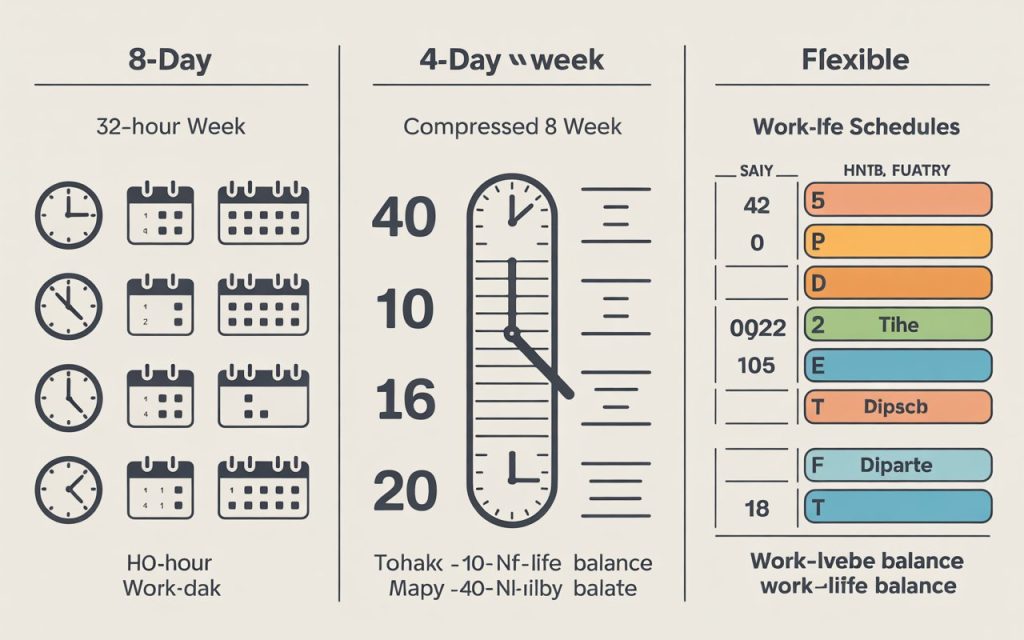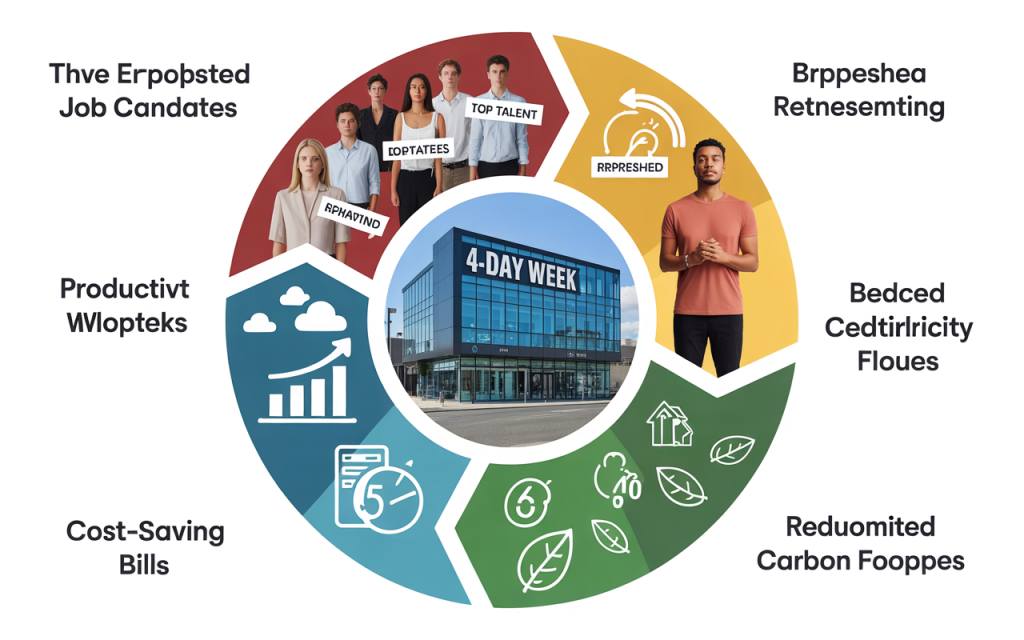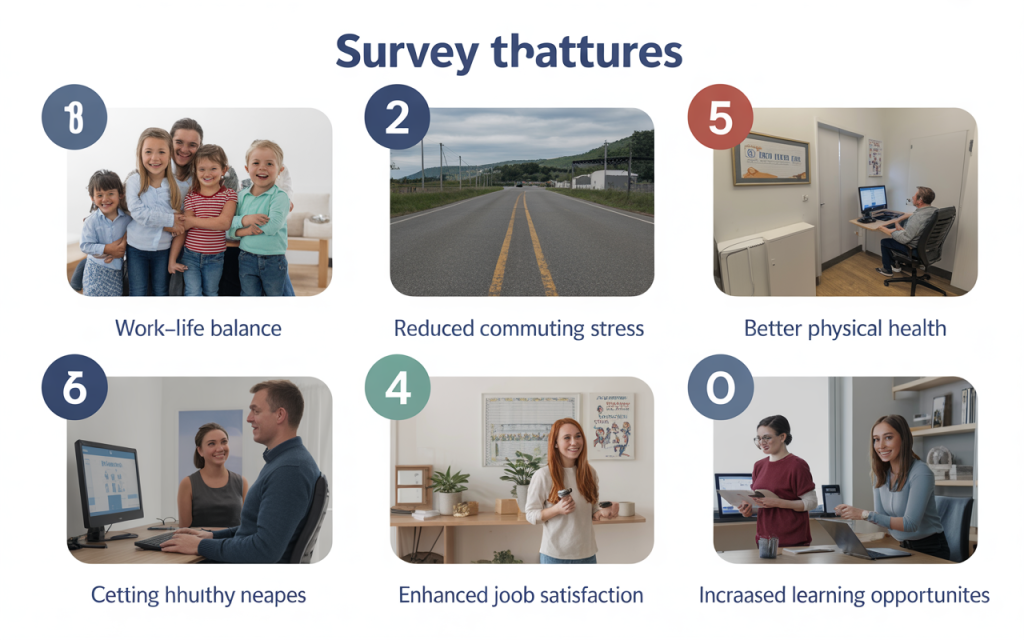4-Day Workweek: Revolutionary Future of Productivity
Future workplace trends support 4-day workweek adoption.

4-day workweek is becoming one of the most talked-about workplace changes in modern times. Companies around the world are testing this new way of working, and the results are surprising many business leaders. But is the 4-day workweek really the future of how we work? This article will explore everything you need to know about this revolutionary work schedule in simple, easy-to-understand language.
What Is a 4-Day Workweek?
A 4-day workweek means employees work only four days instead of the traditional five days per week. Most companies that try this schedule give workers the same pay for fewer working days. The idea is simple: work smarter, not longer.
There are different ways companies can set up a 4-day workweek:
- 32-hour week: Employees work 8 hours for 4 days (32 total hours)
- Compressed week: Employees work 10 hours for 4 days (40 total hours)
- Flexible schedule: Different departments work different four-day combinations
The most popular version is the 32-hour 4-day workweek where employees get the same pay for working fewer hours. This approach focuses on productivity rather than time spent at work.

The History Behind the 4-Day Workweek Movement
The 4-day workweek idea is not completely new. In the 1970s, some companies tried shorter work weeks during the oil crisis to save energy. However, the modern 4-day workweek movement started gaining serious attention around 2019.
The COVID-19 pandemic changed how people think about work and life balance. Many workers realized they could be productive while working from home. This led to more interest in flexible work arrangements, including the 4-day workweek.
Countries like Iceland, Belgium, and Scotland have run large trials of the 4-day workweek. These trials have provided valuable data about how this work schedule affects productivity, employee happiness, and business success.
Why Companies Are Trying the 4-Day Workweek
Many companies are experimenting with the 4-day workweek for several important reasons:
Attracting Better Employees
In today’s job market, workers want more than just good pay. They want work-life balance and flexibility. Companies offering a 4-day workweek often find it easier to attract talented employees who value their personal time.
Reducing Employee Burnout
Burnout is a serious problem in many workplaces. Employees who work too much become stressed, tired, and less productive. The 4-day workweek gives workers more time to rest and recharge, which can reduce burnout significantly.
Improving Productivity
This might sound strange, but many companies find that employees are more productive during a 4-day workweek. When people know they have less time to complete their work, they often focus better and waste less time.
Saving Money
Companies can save money with a 4-day workweek by using less electricity, heating, and office supplies. Some businesses also find they need less office space when employees work fewer days.
Environmental Benefits
Fewer working days mean less commuting, which reduces pollution and traffic. Many companies care about environmental responsibility, and the 4-day workweek helps them reduce their carbon footprint.

Real Success Stories of 4-Day Workweek Implementation
Several companies have successfully implemented the 4-day workweek with impressive results:
Microsoft Japan
In 2019, Microsoft Japan tried a 4-day workweek for one month. The results were amazing: productivity increased by 40%. Employees were happier, used less electricity, and printed fewer pages. This trial showed that the 4-day workweek could work even in a traditional business culture like Japan.
Perpetual Guardian (New Zealand)
This trust company permanently adopted a 4-day workweek after a successful trial. Employee stress levels dropped by 7%, and work-life balance scores improved by 24%. The company maintained the same level of service while employees worked fewer hours.
Thrive Global
This wellness company implemented a 4-day workweek and found that employees were more creative and focused. The extra day off allowed workers to pursue personal interests, which actually made them better at their jobs.
Buffer
The social media management company tried a 4-day workweek during the pandemic. They found that employee happiness increased significantly, and productivity remained high. Many employees used their extra day for learning new skills or spending time with family.
The Science Behind 4-Day Workweek Productivity
Research shows that the 4-day workweek can improve productivity in several ways:
Better Focus and Concentration
When people know they have limited time to complete tasks, they tend to focus better. The 4-day workweek creates a sense of urgency that can eliminate time-wasting activities like excessive meetings or social media browsing.
Improved Mental Health
Extra rest time helps employees manage stress and anxiety better. When workers feel mentally healthy, they make better decisions and work more efficiently. The 4-day workweek provides this crucial recovery time.
Reduced Sick Days
Well-rested employees get sick less often. Companies with a 4-day workweek often see fewer sick days, which means more consistent productivity and lower healthcare costs.
Enhanced Creativity
Creativity often comes when people are relaxed and have time to think. The 4-day workweek gives employees mental space to develop innovative ideas and solutions.

Challenges of Implementing a 4-Day Workweek
While the 4-day workweek has many benefits, it also presents some challenges:
Customer Service Concerns
Some businesses worry about serving customers when employees work fewer days. Companies need to plan carefully to ensure customer needs are met during a 4-day workweek.
Industry Limitations
Certain industries, like healthcare, retail, or manufacturing, may find it difficult to implement a 4-day workweek. These businesses often need continuous coverage or have production requirements that don’t fit shorter schedules.
Workload Management
Fitting five days of work into four days can be stressful if not managed properly. Companies must carefully plan workflows and priorities to make the 4-day workweek successful.
Client Expectations
Some clients may expect businesses to be available five days a week. Companies considering a 4-day workweek need to communicate clearly with clients about their new schedule.
Team Coordination
When different team members work different four-day schedules, coordination can become complicated. Companies need good communication systems to make the 4-day workweek work smoothly.
How Different Industries Are Adapting to the 4-Day Workweek
Various industries are finding creative ways to implement the 4-day workweek:
Technology Companies
Tech companies are leading the 4-day workweek movement. Many software companies find that programmers and designers are more creative and productive when they work fewer hours. The nature of tech work often allows for flexible scheduling.
Marketing Agencies
Creative agencies are embracing the 4-day workweek because creativity benefits from rest and inspiration. Many agencies find that their teams produce better work when they have more time for personal experiences and reflection.
Financial Services
Some financial companies are trying the 4-day workweek for back-office operations. While customer-facing roles may need traditional schedules, many administrative and analytical positions work well with shorter weeks.
Manufacturing
Manufacturing companies face unique challenges with the 4-day workweek. Some have implemented longer daily shifts to maintain production levels, while others have staggered schedules to keep operations running five days a week.
Healthcare
Healthcare organizations are exploring the 4-day workweek for administrative staff and some clinical roles. While emergency services need continuous coverage, many healthcare support functions can adapt to shorter schedules.

Global Trials and Government Support for 4-Day Workweek
Several countries and regions have conducted large-scale 4-day workweek trials:
Iceland’s Groundbreaking Trial
Iceland conducted one of the world’s largest 4-day workweek trials from 2015 to 2019. Over 2,500 workers participated, representing about 1% of the country’s workforce. The results were overwhelmingly positive: productivity maintained or improved while employee wellbeing increased significantly.
United Kingdom’s Pilot Program
The UK ran a six-month 4-day workweek trial involving 100 companies and over 2,600 employees. Most participating companies reported maintained or improved productivity, with 55% of companies planning to continue the 4-day workweek permanently.
Belgium’s Legal Framework
Belgium has laws that allow employees to request a 4-day workweek without losing benefits. This legal support makes it easier for workers to negotiate shorter schedules with their employers.
Scotland’s Public Sector Trial
Scotland is testing the 4-day workweek in public sector organizations. This trial will provide valuable data about how government services can maintain quality while employees work fewer hours.
The Economic Impact of 4-Day Workweek
The 4-day workweek has broader economic implications beyond individual companies:
Increased Consumer Spending
When people have more free time, they often spend more money on entertainment, travel, and leisure activities. This increased spending can boost local economies and create jobs in service industries.
Reduced Healthcare Costs
Healthier, less stressed employees need less medical care. The 4-day workweek could reduce healthcare costs for both employers and society as a whole.
Environmental Benefits
Fewer commuting days mean less pollution and reduced infrastructure wear. The 4-day workweek could contribute to environmental goals and reduce public transportation costs.
Tourism Growth
With three-day weekends every week, people may travel more often. This could boost tourism industries and create economic opportunities in travel-related businesses.
Employee Perspectives on the 4-Day Workweek
Workers who have experienced the 4-day workweek generally report positive outcomes:
Improved Work-Life Balance
Employees consistently report better work-life balance during 4-day workweek trials. The extra day off allows time for family, hobbies, education, and personal care.
Reduced Commuting Stress
Less commuting means lower transportation costs and reduced stress. Many employees appreciate saving money on gas, parking, or public transportation during a 4-day workweek.
Better Physical Health
More time for exercise, cooking healthy meals, and adequate sleep improves employee physical health. Many workers report feeling more energetic during a 4-day workweek.
Enhanced Job Satisfaction
Employees often feel more valued when companies offer a 4-day workweek. This benefit can increase loyalty and reduce employee turnover.
Increased Learning Opportunities
The extra day off gives employees time to learn new skills, take courses, or pursue personal development. This learning often benefits their work performance as well.

How to Successfully Implement a 4-Day Workweek
Companies considering a 4-day workweek should follow these steps:
Start with a Trial Period
Begin with a short trial period, such as three to six months. This allows companies to test the 4-day workweek without making permanent commitments.
Set Clear Goals and Metrics
Define what success looks like before starting. Measure productivity, employee satisfaction, customer service, and financial performance during the 4-day workweek trial.
Communicate with All Stakeholders
Inform employees, customers, suppliers, and partners about the 4-day workweek trial. Clear communication prevents confusion and manages expectations.
Adjust Workflows and Processes
Review and optimize work processes to fit the 4-day workweek schedule. Eliminate unnecessary meetings and streamline decision-making processes.
Provide Training and Support
Help employees adapt to the 4-day workweek by providing time management training and productivity tools. Support is crucial for successful implementation.
Monitor and Adjust
Regularly review how the 4-day workweek is working and make adjustments as needed. Flexibility is key to finding the right approach for each organization.
The Future of Work and 4-Day Workweek
The 4-day workweek represents a broader shift in how society thinks about work:
Technology’s Role
Automation and artificial intelligence are making workers more productive. As technology handles routine tasks, the 4-day workweek becomes more feasible for many jobs.
Changing Worker Expectations
Younger generations prioritize work-life balance more than previous generations. The 4-day workweek aligns with these changing expectations and values.
Post-Pandemic Work Culture
COVID-19 changed how people think about work and life. Many workers now prioritize flexibility and wellbeing, making the 4-day workweek more attractive.
Global Competition for Talent
As remote work becomes common, companies compete globally for talent. Offering a 4-day workweek can be a significant competitive advantage in attracting top employees.

Potential Drawbacks and Criticisms of 4-Day Workweek
Despite its benefits, the 4-day workweek faces some criticism:
Productivity Pressure
Some employees feel pressure to accomplish the same amount of work in less time. This pressure can create stress and potentially reduce the benefits of the 4-day workweek.
Inequality Concerns
Not all jobs can offer a 4-day workweek. This could create inequality between workers who can access this benefit and those who cannot.
Economic Disruption
Large-scale adoption of the 4-day workweek could disrupt traditional business models and economic structures. Some economists worry about unintended consequences.
Implementation Costs
Transitioning to a 4-day workweek requires planning, training, and system changes. These upfront costs may be challenging for some businesses.
Conclusion: Is the 4-Day Workweek Really the Future?
The evidence suggests that the 4-day workweek could indeed be the future of productivity for many organizations. Successful trials around the world show that companies can maintain or improve productivity while giving employees better work-life balance.
The success of the 4-day workweek ultimately depends on thoughtful implementation, clear communication, and a genuine commitment to both productivity and employee wellbeing. As society continues to evolve, work arrangements like the 4-day workweek may become the new normal rather than the exception.




